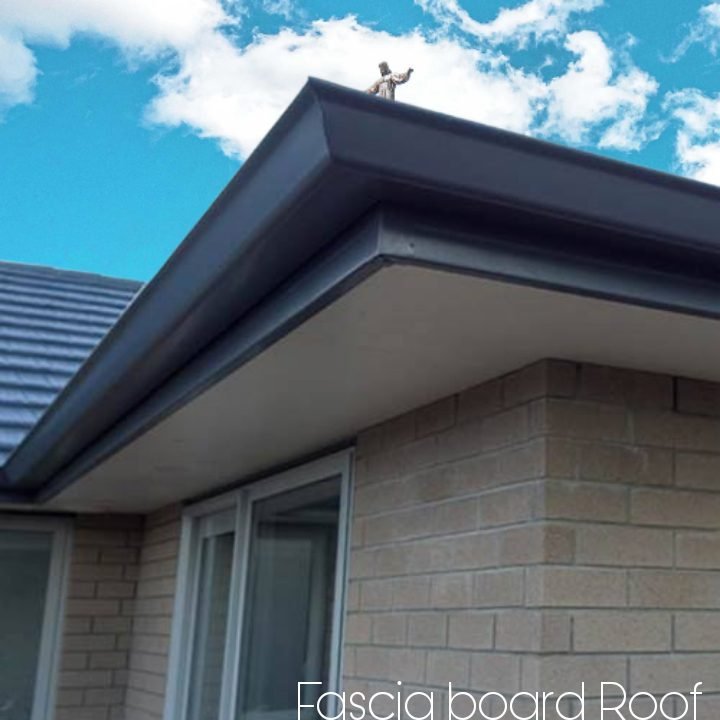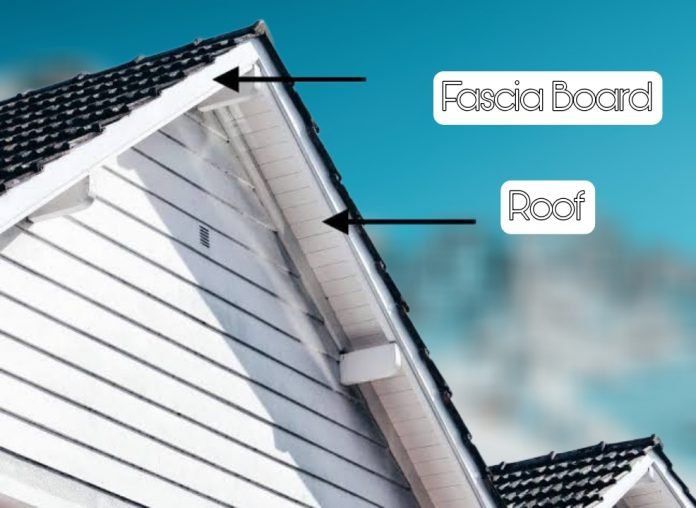Last Updated on February 19, 2024 by Nasir Hanif
Roof Fascia Boards aren’t usually the first item that comes to mind when considering shingles or roofing repairs, but they’re an essential component of the equation for ensuring the integrity and safety of your roof and home. The longitudinal Roof Fascia Boards that extend the entire length of a home’s sides and are located directly behind the drains are known as fascia. They are typically built of wood, sometimes coated in metal, while contemporary development occasionally prefers plastic and other structural components for these boards.
Table of Contents
What Is A Roof Fascia, And Why Is It Significant?
Located on the border of the roof, the fascia is a length of wood that extends horizontally. Fascia is typically 28 or 26 in size. This piece of wood joins the roof structure and drains. Since your fascia boards are coated with a plastic or aluminum top to match your drainage system, you won’t see any wood in this area. Fascia boards are a common feature of houses; very few do not. Typically, it is against building rules to have a property without a fascia board, so this situation needs to be fixed.
The fascia serves multiple functions, including providing a secure installation for downspouts. A hole in your roof would allow you to access the rooftop without the fascia. The fascia, therefore, protects your roof from the elements and pests. Additionally, it has a nice appearance, particularly when capped to match the gutters.
What Sort Of Wood Works Best As A Fascia Board?

The particular roof, environment, and finances are essential when selecting components for your fascia board. The best course of action is to consult a qualified roofer who knows your needs before deciding.
Several kinds of wood are suitable for making fascia boards. Popular and inexpensive options include oak, birch, and juniper. In contrast, some roofers prefer fascia boards made of timber, oak, or pine. These woods are more moisture-resistant and expensive, even though they are not sealed. If you desire to use a unique type of timber for your fascia board, you might need to add something to keep moisture out.
A Fascia Board Serves What Purpose?
The main purpose of a fascia board is to preserve your home from inside and outside humidity harm via obstructing water penetration. Due to this, it is essential that the fascia board appropriately holds and secures the gutters. The fascia prevents dampness and excessive water accumulation, which benefits your home and commercial and domestic roofing systems. Roof Fascia Boards often have decorative value, concealing any exposed roof trusses, and the rough, open ends of the rafters may give your roof a finished appearance. Your home’s curb appeal may go up as a result.
The Right Time To Replace Your Roof Sheathing And Fascia
When it’s time to replace your fascia and roof structure, there are seven symptoms you should look out for:
- Wood with soft spots indicates that decay or cracks are developing.
- Age-related plaster cracking and breaking is a common symptom.
- Indications of birds and vermin, rabbits, squirrels, and bats, can make homes in the smallest spaces and indicate the condition of your roofing.
- Damaged fascia and gutters that appear to have hazardous material are a warning that you should have a professional inspect the building.
- Something is leaking because there is liquid in the roof void.
- Evidence of condensation is always causing concern.
- Not enough ventilation.
The following alternatives are available to homeowners who have decaying fascia boards to restore the appearance of their home:
- The most straightforward alternative is to cover the original fascia boards with UPVC paneling; however, if the fascia boards are crumbling away, the coating can’t tolerate it. Considering replacement wood fascia boards, the coating might be an option to shield them from inclement weather.
- The second choice is to remove the weather-beaten fascia boards and install new timber fascia in their place. This may be a good option if you want to decorate and take care of your fascia. Before putting up, timbers will need to be treated for preservation.
- It is advised to switch out wooden fascia for UPVC boards instead because UPVC needs very little upkeep and is weatherproof and lasting.
Fascia Board Materials: What They Are, How to Choose Them, and Getting Tips.
Most households only view fascia as an ornamental element of the roof installation. However, they are essential in roofing and serve a significant protective role for the roofing and your house. You should consider installing the new fascia boards if your newer ones are damaged or if you are building new Roof Fascia Boards. Various styles and types of fascia boards are available. To help you choose the best one for your home, weigh the benefits and drawbacks of each option and fit it to your interests and financial situation.
The board that encompasses the entire roof is known as the fascia. It is fastened to the ceiling directly beneath the roof shingles or tiles. The fascia is a board that spans the entire width of the roof. It is connected to the top of the structural frame and is placed directly beneath the roof shingles or tiles. In addition to carrying the guttering system for the house, it also protects the roof from the elements.
Choosing the Right Fascia Board Material
When considering roof fascia boards, selecting the appropriate material is crucial for ensuring durability and longevity. Various materials are available, each with its own advantages and considerations. Here’s a breakdown of common fascia board materials:
Timber: Timber fascia boards offer versatility and can be relatively inexpensive. With proper coating or treatment, they can resist moisture effectively, enhancing their durability. Painting over timber fascia boards further enhances their longevity and aesthetic appeal.
Epoxy: Epoxy fascia boards, made from a combination of recovered wood pellets and shavings mixed with epoxy resin, offer exceptional durability. While they may cost more than other options, epoxy fascia boards boast natural decomposition resistance and robustness, making them a sustainable choice for long-term use.
PVC: PVC fascia boards, engineered to resemble wood, offer superior resistance to rot and decay compared to traditional timber. They are particularly suitable for environments prone to moisture or humidity. Additionally, PVC fascia boards are available in various colors, providing flexibility in matching different architectural styles and preferences.
Each material has its own set of benefits and considerations, so it’s essential to weigh these factors against your specific requirements and budget before making a decision. Consulting with a qualified roofer can provide valuable insights and guidance tailored to your needs, ensuring you choose the right fascia board material for your roof and home.
· Timber
With suitable coating or preparation, wood fascia boards can be inexpensive, versatile, and water-resistant. Once you color over it, it becomes more durable.
· Epoxy
The recovered wood pellets and shavings used to make this substance are combined with epoxy coating. It costs more than the other options on this list. Therefore, it isn’t as popular, but it decomposes naturally, is sustained and controlled, and is sturdy.
· PVC as a Component for Fascia
Despite being constructed using the same technology as plumbing fixtures, a Vinyl fascia board is designed to seem like wood. When compared to wood, it has a definite advantage in rotting protection. It looks best on vinyl or aluminum exteriors, while it also brightens homes with wood, bricks, or limestone sympathizing. PVC fascia board is paintable and available in several colors. Since PVC grows more than wood, professionals typically bond the connections and fix them using pointed staples instead of finishing staples.
Significant Benefits of Fascia Board Roof

- To Increase Energy Efficiency
Fascia and ceiling panels serve as our homes’ primary line of protection against the elements, whether rain, storm, or even snowfall. This can harm reducing heating costs because they add to the initial line of defense. The cold will keep you from spending as much on heating. Long-term expenditures can be reduced by upgrading fascia and soffits and installing double or triple-glazed windows.
- Easily Maintained
If your building’s fascia and interior walls are sturdy and well erected by a contractor you can rely on, they require comparatively little upkeep. You may be confident that your home will be substantially better protected after installation. With UPVC fascia and gutters, care is negligible to nonexistent; they could need periodic cleaning, but other than that, they ought to endure for many years.
- Increasing the Worth of Your House
A fascia board can raise the value of your house, allowing you to demand a considerably greater price should you choose to sell it in the future. This is so that you can keep your home, specifically its roof, in good condition. Additionally, since you may already improve the appearance of your home with the installation of these boards, potential purchasers will find it more visually appealing.
A Beautiful Exterior
When your drainage system is overlooked, it may seriously degrade the value of your home, especially if it is leaking or clogged with leaves. Therefore, you’ll see how much an upgrade to your drainage system, whether it be your whole drainage framework or maybe just your fascia and skirting boards, can change the appearance of your home and increase its energy efficiency. Additionally, a wide range of color options is available for uPVC soffits and fascia, allowing you to select the perfect color to complement the design of your home.
What Size Fascia Board Thickness Is Best Suited?
The longitudinal plank that is nailed to the roofline of each rope and used to close the space between each one is known as a fascia. Most builders and contractors use 3/4″ or 1″ thick lumber, which requires regular maintenance. PVC has recently replaced this material as the preferred option.
Conclusion
Keeping your overall building style in mind is essential. Pay close attention to the location and seasonal changes in which the Roof Fascia Boards will be employed. You will choose a solution depending on how much money you spend. Azek Timber Tech-equipped homes will ultimately triumph in the lifespan race. Choose a product that fits your budget and where it will be installed.
Apart from this, if you want to know more about The Benefits of Using Wood Wall Paneling then visit our Home Improvement category.
FAQs
The fascia board keeps dampness or water out of the area under your roof by shielding the extremities of beams and truss.
Let’s first distinguish trim and fascia to understand their official tasks fully. Housing trim is the covering used to decorate doors and windows, among several other external components. At the same time, a building fascia is a straight or curved board that covers the border or wall of the protruding roofline.
Fascia boards made of composite material typically replace outdated metal or wood ones. These boards were created to get the entire depth of complexity that a wood look offers but with the sturdiness and lifespan required for a roofline because it is at the forefront of use.















